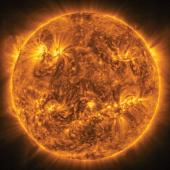The Sky Boys
There were the Youngers. And the Doolins. And who could forget Frank and Jesse James? In the Wild West, brothers had a way of becoming notorious. It’s no different in the sky, where another set of brothers—the Gemini boys—ride high every winter’s night.
Look above and right of the rectangle of Orion, and you’ll find another rectangle with two bright stars anchoring the upper end. This pattern outlines the brothers, with the bright stars, white Castor and orangish Pollux, marking the heads of the twins of the same names. They pass just shy of overhead in the mid-evenings of frigid January.
The Geminis take the cake for unusual starts in life. The god Zeus, taking a shine to their mother Leda, consorted with her one night in the guise of a swan. Leda subsequently produced two eggs. From one hatched Pollux and Helen (of Troy), the immortal offspring of the god; from the other emerged Castor and Clytemnestra, the more ordinary progeny of Leda’s actual husband, King Tyndareus of Sparta. In true Spartan fashion, the boys grew up rough and tough, Castor excelling at horsemanship and Pollux at boxing.
When Jason was recruiting Argonauts to join him on the quest to gain the Golden Fleece — the pricey ram’s pelt nailed to a tree in the land of Colchis — the adventure-seeking brothers signed on. They stuck with Jason through thick and thin, proving to be good men in a fight and having an uncanny knack for pulling the good ship Argo through frightful storms. This earned them special favor with sailors of later eras, who considered them patrons and generally good luck. During storms, when the electrical phenomena called St. Elmo’s fire played among the rigging of ships, the appearance of two separate glows was said to be the twins come to save the crew and guide them to safety. (One glow was considered to be their sister Helen, and not a good sign at all.)
Following their tour of duty with Jason, the brothers found other mischief to get into, especially with another pair of brothers named Idas and Lynceus. And as should not surprise, the two families eventually had a falling out, western-style. Some stories say it was over a pair of pretty girls, another says it was over some rustled cattle; the upshot was that in the ensuing fight, Castor (remember, he was the mortal one) was killed. The immortal Pollux was heartbroken, and rather than have his son mope about, Zeus decided to place them both in the sky, granting a measure of immortality to both. And so the reunited pair remain today.
The Greeks weren’t the only ones to see twins in the stars of Gemini. For many native cultures of the American Northern Plains, they were the War Twins, brothers who also had many adventures before departing to the sky. And they’re still causing sparks. Every mid-December, around the 13th and 14th, a meteor shower known as the Geminids shoots from a direction right near Castor’s head; it’s one of the best such showers of the year.
This winter in particular, the brothers host the planet Mars for its opposition on Christmas Eve. On this night, the Red Planet lays exactly opposite the sun in the sky, rising at sunset with the brothers and setting at sunrise on Christmas morning. Mars hangs out nearby for the rest of the winter, tangling in the horns of Taurus the Bull in January, and drifting back across Gemini by spring.
So tip your hat toward the brothers in the sky the next cold, clear night. Frank and Jesse may be gone, but the Gemini boys still ride, hell-bent for leather over the snow-clad hills of winter.
Jim Manning is executive director of the Astronomical Society of the Pacific in San Francisco, California, but maintains roots just "Outside Bozeman."











